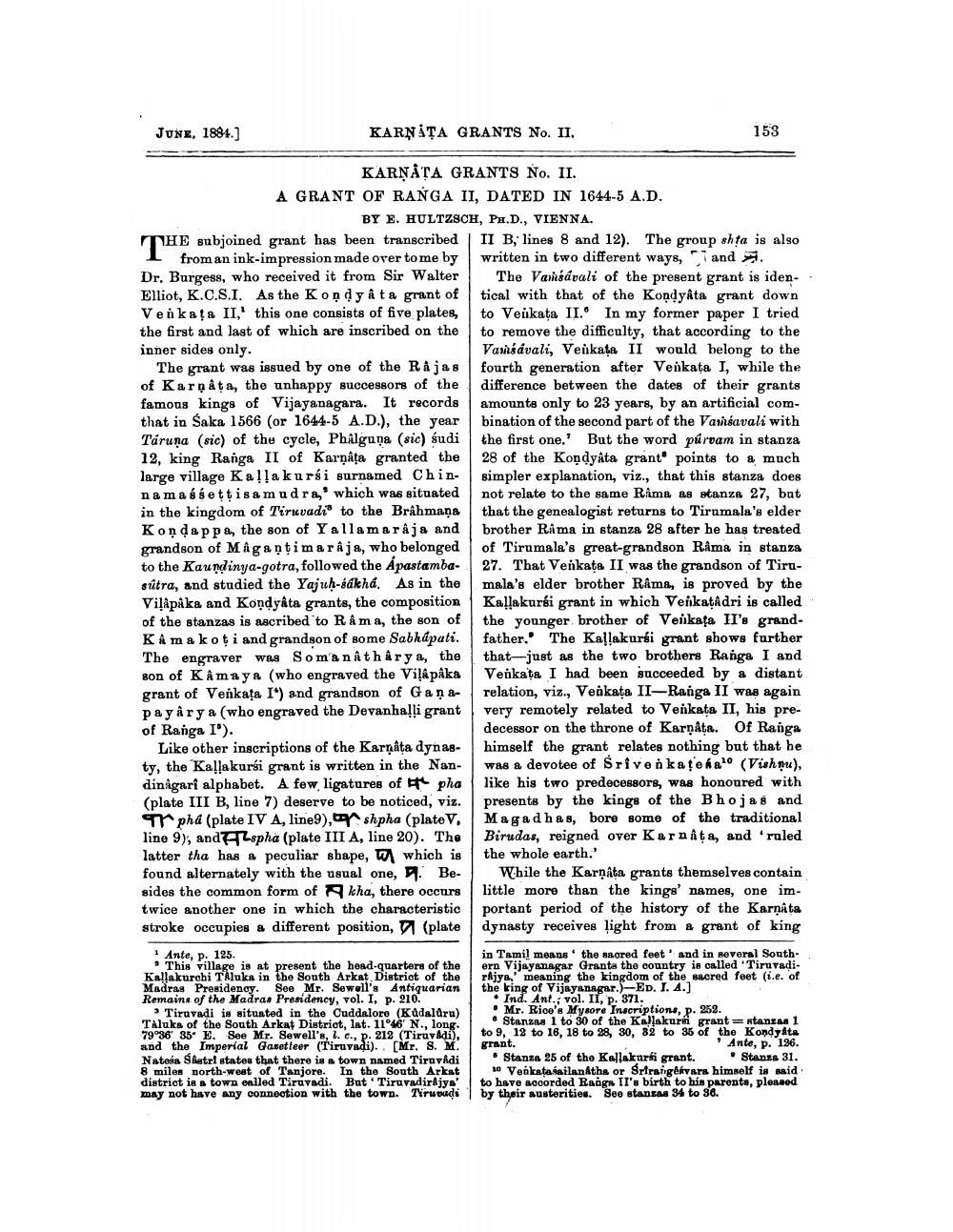________________
JUNE, 1884.]
KARNATA GRANTS No. II.
KARNATA GRANTS No. II.
A GRANT OF RANGA II, DATED IN 1644-5 A.D. BY E. HULTZSCH, PH.D., VIENNA.
THE THE subjoined grant has been transcribed from an ink-impression made over to me by Dr. Burgess, who received it from Sir Walter Elliot, K.C.S.I. As the Kondyât a grant of Venkata II, this one consists of five plates, the first and last of which are inscribed on the inner sides only.
The grant was issued by one of the Rajas of Karnata, the unhappy successors of the famous kings of Vijayanagara. It records that in Saka 1566 (or 1644-5 A.D.), the year Táruna (sic) of the cycle, Phalguna (sic) sudi 12, king Ranga II of Karnâța granted the large village Kallakursi surnamed Chinnamasseṭṭisamudra, which was situated in the kingdom of Tiruvadi to the Brahmana Kondappa, the son of Yallamaraja and grandson of Magaṇṭimaraja, who belonged to the Kaundinya-gotra, followed the Apastambasútra, and studied the Yajuḥ-sákhá. As in the Vilapaka and Kondyâta grants, the composition of the stanzas is ascribed to R âm a, the son of Kama koti and grandson of some Sabhápati. The engraver was Somanâtharya, the son of KAmaya (who engraved the Vilâpâka grant of Venkata I) and grandson of Ganapayarya (who engraved the Devanhalli grant of Ranga I').
Like other inscriptions of the Karnata dynasty, the Kallakursi grant is written in the Nandinagari alphabet. A few ligatures of pha (plate III B, line 7) deserve to be noticed, viz. phá (plate IV A, line9), shpha (plateV, line 9), andspha (plate III A, line 20). The latter tha has a peculiar shape, which is found alternately with the usual one, Besides the common form of kha, there occurs twice another one in which the characteristic stroke occupies a different position, (plate
1 Ante, p. 125.
This village is at present the head-quarters of the Kallakurchi Taluka in the South Arkat District of the Madras Presidency. See Mr. Sewell's Antiquarian Remains of the Madras Presidency, vol. I, p. 210.
Tiruvadi is situated in the Cuddalore (Kudalûru) Taluks of the South Arkat District, lat. 11°46' N., long. 79°36′ 35 E. See Mr. Sewell's, l. c., p. 212 (Tiruv&di), and the Imperial Gazetteer (Tiruvadi).. [Mr. S. M. Natosa Sastri states that there is a town named Tiruvadi 8 miles north-west of Tanjore. In the South Arkat district is a town called Tiruvadi. But Tiruvadirajya' may not have any connection with the town. Tiruvaḍi
153
II B, lines 8 and 12). The group shta is also written in two different ways, and .
The Vasávali of the present grant is identical with that of the Kondyâta grant down to Venkata II. In my former paper I tried to remove the difficulty, that according to the Vamsávali, Venkata II would belong to the fourth generation after Venkata I, while the difference between the dates of their grants amounts only to 23 years, by an artificial combination of the second part of the Vamsavali with the first one.' But the word púrvam in stanza 28 of the Kondyâta grant points to a much simpler explanation, viz., that this stanza does not relate to the same Rama as stanza 27, but that the genealogist returns to Tirumala's elder brother Råma in stanza 28 after he has treated of Tirumala's great-grandson Râma in stanza 27. That Venkata II was the grandson of Tirumala's elder brother Râma, is proved by the Kallakursi grant in which Venkatâdri is called the younger brother of Venkata II's grandfather. The Kallakursi grant shows further that just as the two brothers Ranga I and Venkata I had been succeeded by a distant relation, viz., Venkata II-Ranga II was again very remotely related to Venkata II, his predecessor on the throne of Karnata. Of Ranga himself the grant relates nothing but that he was a devotee of Srivenkatekalo (Vishnu), like his two predecessors, was honoured with presents by the kings of the Bhojas and Magadhas, bore some of the traditional Birudas, reigned over Karnata, and 'ruled the whole earth.'
While the Karnata grants themselves contain little more than the kings' names, one important period of the history of the Karnata dynasty receives light from a grant of king
<
in Tamil means the sacred feet and in several Southern Vijayanagar Grants the country is called 'Tiruvadirajya, meaning the kingdom of the sacred feet (i.e. of the king of Vijayanagar.)-ED. I. A.]
Ind. Ant., vol. II, p. 371.
Mr. Rice's Mysore Inscriptions, p. 252.
Stanzas 1 to 30 of the Kallakurai grant stanzas 1 to 9, 12 to 16, 18 to 28, 30, 82 to 35 of the Kondyta grant. Ante, p. 136. ⚫ Stanza 31.
Stanza 25 of the Kallakursi grant. 10 Venkatasailantha or Srirangêvara himself is said to have accorded Ranga II's birth to his parents, pleased by their austerities. See stanzas 34 to 36.




